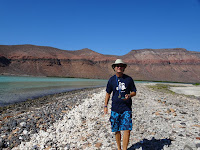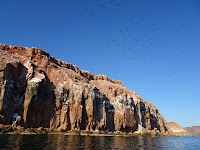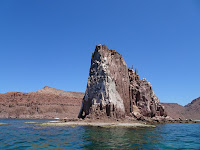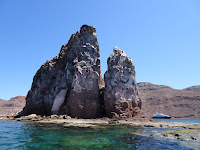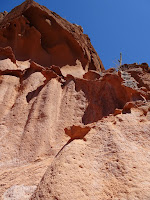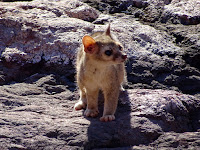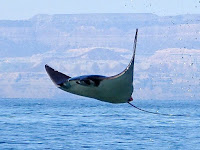We dropped the dinghy for a tour of beautiful Balandra Bay. Surrounded by huge, crumbling walls of conglomerate, it didn’t look uniform enough to have been laid down as seabed, but instead like a pyroclastic layer that was the result of some massive volcanic calamity. Softer, weaker sections had fallen away, leaving lots of sea caves fronted by giant boulders, and between these areas again were dunes and sandy beaches.




Lovely weather to explore and way less frustrating than the internet!
The tourist view was completely hidden from our view at anchor
Deeper into the bay, the white sand of the bottom rose up to meet us. We slowed the motor way down so that if we touched bottom with it the propeller would just bump, bump, bump into the sand without hurting anything. (One of the nice things about having an electric motor is that there is no minimum idle speed, so we can slow it way down to where the prop is turning at just a few rpm, dramatically reducing the chance that it will be damaged if it strikes something unexpected.).
When we finally did touch bottom, we had maybe half of the bay still between the beach and us. We lifted the motor, I jumped over the side, grabbed the painter and towed the boat towards shore without even getting my shorts wet. When it got to ankle depth, Maryanne got out and helped. We were still 100 meters from the beach when the unladen dinghy grounded. We threw out the anchor and waded in without it.


Heading towards the promise of food!
What a great beach! The sand is as soft as sugar and almost the same color. The shallow water is heated by the sun and takes a long distance to get deep, making it the perfect wading pool where parents can let their kids wander anywhere within shouting range and not have to worry.
We walked to the snack shack in the corner of the parking lot, where we bought a smoked marlin burrito, a chicken tamale and an iced cold Coke for 100 pesos; that kept us going for the rest of our circuit. We walked the dinghy over to the next beach for the obligatory pictures of El Hongo – The Mushroom – a big rock on a narrow pillar left by erosion. There’s actually a lot of these around, but this one is famous, probably because of its accessibility to La Paz. Actually, it’s a bit of a fake. Vandals broke it off a while ago (It probably would have fallen over soon anyway), but it’s since been restored with a crane and some concrete.


And on to El Hongo!
Beyond El Hongo, the water became deep enough again for us to need the dinghy. We climbed back in and took a tour of the rocks and tide pools where the Balandra meets with larger La Paz Bay.
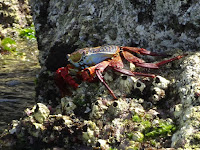

Poking around


Back at the boat - Kyle does one last chore up the mast
We had one more night of forecast strong Coromuel winds before the arrival of a strong Norther. That would likely turn Balandra into a dangerous, frothing mess. Once the wind died down with the arrival of morning, we pulled up anchor and headed south to Caleta Lobos, just a mile or so away. Caleta Lobos is well protected from three sides and seems to be a safe place to wait out the blow. When we arrived, it was just us and one other boat way in the other corner. By late afternoon, most of the other boats that had been anchored with us in Balandra showed up and started staking out their spots. It was a shame we had to leave. Caleta Lobos is not nearly as pretty as Balandra. The hills are soft and brown and covered uniformly with brown brush, making the whole area look like dried-up piles of dirt. There is just a bit of marshland tucked way up in the shallows. That and the guano on the nearby islands makes for a lot of bobos – those annoying little flies that seem to exist solely to drive people insane. The good thing is that there is a very slightly better cell phone signal. That and all of the power from the sun and wind will pretty much dictate the nature of our stay.
So, in the meantime, we attempt to be responsible and prepare ourselves with planning and research ready for both our stay in La Paz and pending passages beyond.
We have a reservation at a Marina in La Paz for the 27th March and it seems we were lucky to get that since there is a festival on in town.. Once we make it there, we will be full steam ahead in 'work' mode, but still hope for some fun along the way.














